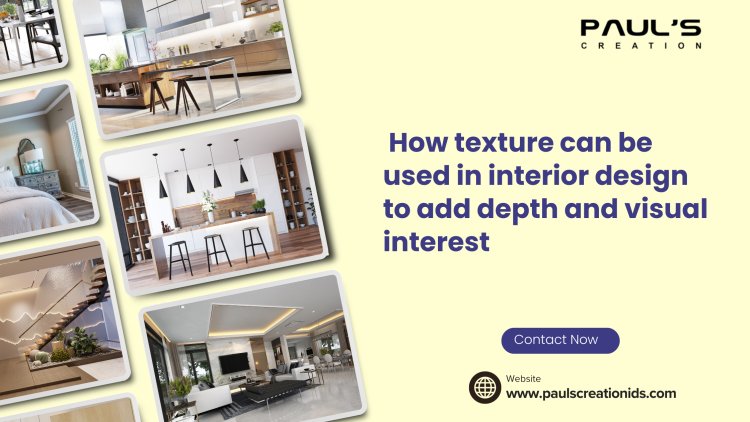How texture can be used in interior design to add depth and visual interest
Share this Post to earn Money ( Upto ₹100 per 1000 Views )

Regarding interior design, texture is often the unsung hero that brings a space to life. While color, shape, and light are key elements in creating a coherent, beautiful interior texture adds depth and dimension, transforming a flat, lifeless space into a dynamic, intriguing environment. Understanding how to use texture effectively is key to creating a balanced, harmonious design that appeals to the senses. In this, we explore how texture can be used in interior design to add depth and visual interest, making a space feel, not just look at.
Understanding Texture in Interior Design:
Texture in interior design refers to the surface quality of a material and what it feels or can be when touched. There are smooth, rough, soft, hard, glossy, and matte textures, each of which evokes different emotions and responses. Smooth and shiny textures like glass and metal are associated with a sleek and modern look while rough textures like wood and stone can evoke a sense of warmth and rustic charm.
The texture doesn’t just mean the physical feel it also means the visual texture. For example, a patterned wallpaper can give the impression of texture even if it is physically smooth. Visual texture plays an important role in our perception of space influencing our emotional response and the overall atmosphere of a room.
Add depth with texture:
One of the biggest benefits of incorporating texture into your interior design is how texture adds depth to a space. Depth in your design doesn't just mean the physical space but also how layers and contrast create a sense of dimension.
1. Layer different textures:
Combining materials with different textures such as a soft wool rug placed over a smooth hardwood floor or a rough stone wall next to a smooth glass surface, creates eye-catching contrasts and adds complexity to your design. This interplay of different textures makes the room look richer and more dynamic.
For example, placing a chunky knit blanket over a leather sofa in your living room creates a soothing tactile contrast that's perfect for touching and interacting. Similarly, layering different fabrics in your bedroom, like silk pillows, linen blankets, and a velvet headboard, creates a luxurious and inviting atmosphere.
2. Use textured materials on walls and floors:
Walls and floors are the largest surfaces in a room and are the perfect canvases for texture. Textured walls can act as a focal point and add character and depth to a room. Materials like exposed brick, stone, and wood paneling add a tactile element that instantly enhances a room's visual appeal. Even wallpaper with a subtle relief pattern can add a layer of sophistication and charm.
When it comes to floors using textured materials like natural stone, wood with a pronounced grain, and even textured tiles can add depth and warmth to a room. For example, a wooden floor with a herringbone pattern not only adds structure but also creates a sense of movement and flow in a room.
3. Incorporate natural elements:
Nature is a rich source of texture and incorporating natural elements into your interior design can greatly enhance the depth and appeal of a space. Elements like wood, stone, plants, and woven fibers bring organic textures that convey a sense of serenity and connection to the natural world.
4. Mix textiles and fabrics:
Textiles are one of the easiest ways to add texture to a room. Combining different fabrics and textiles can create an intriguing, dynamic, multi-layered space. Try combining materials like velvet, silk, linen, and wool in your cushions, throws, and curtains. Each fabric has its unique texture that combines to create a rich, tactile environment.
Add visual interest through texture:
Depth is important but it's visual interest that makes a space intriguing and stimulating. Texture plays a key role in keeping your design from becoming monotonous.
1. Create a focal point:
Strategically use structures to create a focal point in a room. For example, a textured accent wall can draw attention and become the centerpiece of a room. Whether the wall is covered in reclaimed wood, decorated with textured wallpaper, or finished with a stucco finish this area naturally becomes a focal point due to its visual and tactile appeal.
2. Balance texture with other design elements:
When using texture in interior design balance is key. Too much texture can overwhelm the senses while too little can make a room feel flat and uninspired. Balancing textured elements with smoother more neutral surfaces is key to creating harmony in your design. For example, if you have a highly textured accent wall, balance it with sleek, minimalist furniture and accessories in a room with mostly smooth surfaces you can use textured rugs, cushions, or statement furniture to add much-needed depth and visual appeal without cluttering the space.
Conclusion:
Texture is an essential tool in interior design adding depth, dimension, and visual appeal to a space. Carefully selected and combined textures can create a harmonious, balanced environment that is inviting and visually stimulating. Whether layering different materials incorporating natural elements or balancing texture with other design elements effective use of texture can transform any interior from ordinary to extraordinary. Paul's Creation provides top-notch services for Interior Designers in Bangalore.

 paulscreationids
paulscreationids 













